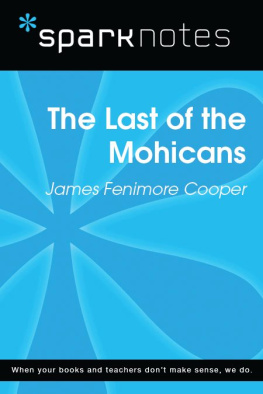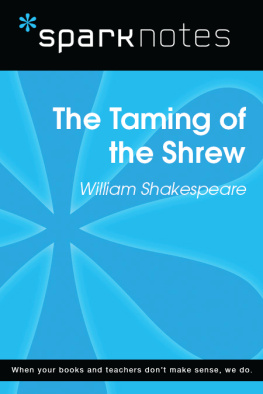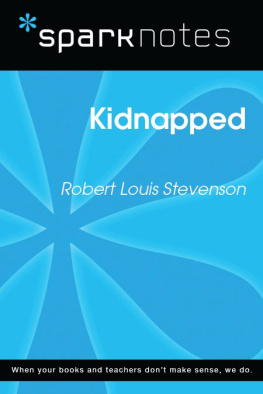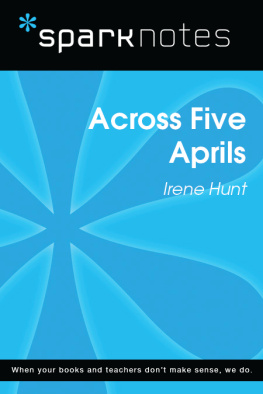The Last of the Mohicans
James Fenimore Cooper
2003, 2007 by Spark Publishing
This Spark Publishing edition 2014 by SparkNotes LLC, an Affiliate of Barnes & Noble
All rights reserved. No part of this publication may be reproduced, stored in a retrieval system, or transmitted in any form or by any means (including electronic, mechanical, photocopying, recording, or otherwise) without prior written permission from the publisher.
Sparknotes is a registered trademark of SparkNotes LLC
Spark Publishing
A Division of Barnes & Noble
120 Fifth Avenue
New York, NY 10011
www.sparknotes.com /
ISBN-13: 978-1-4114-7615-8
Please submit changes or report errors to www.sparknotes.com/.
10 9 8 7 6 5 4 3 2 1
Context
J ames Fenimore Cooper was one of the first popular American novelists. Born in September 1789 in Burlington, New Jersey, Cooper grew up in Cooperstown, New York, a frontier settlement that he later dramatized in his novels. Cooper had a rambling and unpredictable early life. He attended Yale when he was only thirteen but was expelled for instigating a practical joke. His father forced him to join the Navy. Cooper began writing almost by accident. When reading a popular English novel aloud to his wife one day, Cooper suddenly tossed the book aside and said, I could write you a better book myself! He lived up to his claim by writing Precaution in 1820 and The Spy, his first popular success, the following year. For the rest of his life, Cooper attracted a massive readership on both sides of the Atlantic, a following rivaled in size only by that of Sir Walter Scott. When he died in 1851 , Cooper was one of the most famous writers in the world.
After achieving success as a novelist, Cooper spent seven years living in Europe, during which time he wrote many of his most memorable stories. Cooper drew on his memories of his childhood on the American frontier, writing high-spirited, often sentimental adventure stories. These frontier romances feature his best-known character, the woodsman Natty Bumppo, also known as Hawkeye or Leatherstocking. This heroic scout was featured in five novels, known collectively as the Leatherstocking Tales: The Pioneers,The Prairie,The Pathfinder,The Deerslayer, and, most famously, The Last of the Mohicans.
Written in 1826 , The Last of the Mohicans takes place in 1757 during the French and Indian War, when France and England battled for control of the American and Canadian colonies. During this war, the French often allied themselves with Native American tribes in order to gain an advantage over the English, with unpredictable and often tragic results. Descriptions of certain incidents in the novel, such as the massacre of the English soldiers by Huron Indians, embellish accounts of real historical events. Additionally, certain characters in the novel, General Montcalm in particular, are based on real individuals. Creating historically inspired stories was common in nineteenth-century adventure tales. In writing The Last of the Mohicans, Cooper followed the example of his contemporaries Sir Walter Scott and the French writer Alexandre Dumas, whose novel The Three Musketeers takes even greater liberties with historical events and characters than The Last of the Mohicans.
Since his death, Coopers reputation has fluctuated wildly. Victor Hugo and D. H. Lawrence admired him, but Mark Twain considered him a national embarrassment. Twain wrote harsh, humorous criticism of Coopers stylistic excesses, inaccuracies, and sentimental scenes. Even The Last of the Mohicans, widely considered Coopers best work, is an implausible story narrated in a fashion that can seem overwrought to modern readers. Coopers work remains important for its portrait of frontier life and its exploration of the traumatic encounters between races and cultures poised on opposite sides of a shrinking frontier.
Plot Overview
I It is the late 1750s, and the French and Indian War grips the wild forest frontier of western New York. The French army is attacking Fort William Henry, a British outpost commanded by Colonel Munro. Munros daughters Alice and Cora set out from Fort Edward to visit their father, escorted through the dangerous forest by Major Duncan Heyward and guided by an Indian named Magua. Soon they are joined by David Gamut, a singing master and religious follower of Calvinism. Traveling cautiously, the group encounters the white scout Natty Bumppo, who goes by the name Hawkeye, and his two Indian companions, Chingachgook and Uncas, Chingachgooks son, the only surviving members of the once great Mohican tribe. Hawkeye says that Magua, a Huron, has betrayed the group by leading them in the wrong direction. The Mohicans attempt to capture the traitorous Huron, but he escapes.
Hawkeye and the Mohicans lead the group to safety in a cave near a waterfall, but Huron allies of Magua attack early the next morning. Hawkeye and the Mohicans escape down the river, but Hurons capture Alice, Cora, Heyward, and Gamut. Magua celebrates the kidnapping. When Heyward tries to convert Magua to the English side, the Huron reveals that he seeks revenge on Munro for past humiliation and proposes to free Alice if Cora will marry him. Cora has romantic feelings for Uncas, however, and angrily refuses Magua. Suddenly Hawkeye and the Mohicans burst onto the scene, rescuing the captives and killing every Huron but Magua, who escapes. After a harrowing journey impeded by Indian attacks, the group reaches Fort William Henry, the English stronghold. They sneak through the French army besieging the fort, and, once inside, Cora and Alice reunite with their father.
A few days later, the English forces call for a truce. Munro learns that he will receive no reinforcements for the fort and will have to surrender. He reveals to Heyward that Coras mother was part Negro, which explains her dark complexion and raven hair. Munro accuses Heyward of racism because he prefers to marry blonde Alice over dark Cora, but Heyward denies the charge. During the withdrawal of the English troops from Fort William Henry, the Indian allies of the French indulge their bloodlust and prey upon the vulnerable retreating soldiers. In the chaos of slaughter, Magua manages to recapture Cora, Alice, and Gamut and to escape with them into the forest.
Three days later, Heyward, Hawkeye, Munro, and the Mohicans discover Maguas trail and begin to pursue the villain. Gamut reappears and explains that Magua has separated his captives, confining Alice to a Huron camp and sending Cora to a Delaware camp. Using deception and a variety of disguises, the group manages to rescue Alice from the Hurons, at which point Heyward confesses his romantic interest in her. At the Delaware village, Magua convinces the tribe that Hawkeye and his companions are their racist enemies. Uncas reveals his exalted heritage to the Delaware sage Tamenund and then demands the release of all his friends but Cora, who he admits belongs to Magua. Magua departs with Cora. A chase and a battle ensue. Magua and his Hurons suffer painful defeat, but a rogue Huron kills Cora. Uncas begins to attack the Huron who killed Cora, but Magua stabs Uncas in the back. Magua tries to leap across a great divide, but he falls short and must cling to a shrub to avoid tumbling off and dying. Hawkeye shoots him, and Magua at last plummets to his death.
Cora and Uncas receive proper burials the next morning amid ritual chants performed by the Delawares. Chingachgook mourns the loss of his son, while Tamenund sorrowfully declares that he has lived to see the last warrior of the noble race of the Mohicans.



















